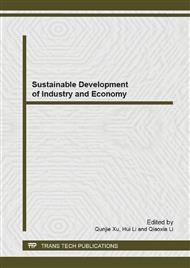p.381
p.385
p.389
p.393
p.399
p.404
p.408
p.416
p.420
The Regional Initial Allocation Model of Carbon Emissions Permits in Power Industry
Abstract:
As the biggest carbon emitters, the power industry is the primary object to reduce its emissions. The construction of power industry carbon emissions of regional initial allocation model can make the development of power industry meets the new requirements of reducing the carbon emission, which has important theoretical significance and practical value. The index system of carbon emissions permits regional allocation was established, which included 5 factors-economy, technology, policy, carbon emissions and energy efficiency. Based on the projection method, considered the characteristics of multiple-goal of carbon emission permits allocation and precision of index value, the projection interval multi-objective allocation method was put forward. East China carbon emission allocation in power industry was taken as an example. The result shows that the model can be more rational, scientific to provide a theoretical reference for regional allocation of electric carbon emissions.
Info:
Periodical:
Pages:
399-403
Citation:
Online since:
December 2013
Authors:
Price:
Сopyright:
© 2014 Trans Tech Publications Ltd. All Rights Reserved
Share:
Citation:


